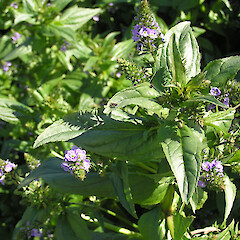Veronica anagallis-aquatica
Common name
water speedwell
Family
Plantaginaceae
Flora category
Vascular – Exotic
Structural class
Herbs - Dicotyledons other than Composites
NVS code
The National Vegetation Survey (NVS) Databank is a physical archive and electronic databank containing records of over 94,000 vegetation survey plots - including data from over 19,000 permanent plots. NVS maintains a standard set of species code abbreviations that correspond to standard scientific plant names from the Ngä Tipu o Aotearoa - New Zealand Plants database.
VERANA
Conservation status
Not applicable
Brief description
Sprawling perennial herb up to 1 m tall with opposite stalkless leaves and small (c. 7 mm across) pale blue or mauve flowers.
Distribution
Maybe locally abundant in the North and South Island.
Habitat
Grows in shallow water or wet soil along slow-moving streams and ditches.
Wetland plant indicator status rating
Information derived from the revised national wetland plant list prepared to assist councils in delineating and monitoring wetlands (Clarkson et al., 2021 Manaaki Whenua – Landcare Research Contract Report LC3975 for Hawke’s Bay Regional Council). The national plant list categorises plants by the extent to which they are found in wetlands and not ‘drylands’. The indicator status ratings are OBL (obligate wetland), FACW (facultative wetland), FAC (facultative), FACU (facultative upland), and UPL (obligate upland). If you have suggestions for the Wetland Indicator Status Rating, please contact: [Enable JavaScript to view protected content]
OBL: Obligate Wetland
Almost always is a hydrophyte, rarely in uplands (non-wetlands).
Detailed description
Fibrous-rooted, perennial plant, more or less erect, 20-100 cm tall, hairless throughout, or slightly glandular-short-hairy among the flowers. Leaves opposite, mostly elliptic or elliptic-ovate to elliptic-oblong, stalkless and mostly clasping, mostly 2-10cm long and 0.7-5 cm wide, 1.5-3 times as long as wide, sharply saw-toothed to entire. Sterile, autumnal shoots have more rounded and stalked leaves. Flowers many in elongated, long-stalked clusters from leaf axils. Sepals highly variable in form and size. Corolla pale blue to mauve with darker nerves, 5-7 mm wide. The flower stalks in fruit generally strongly ascending, or upcurved, 3-8 mm long. Fruit a capsule swollen, 2.5-4 mm across, scarcely notched, about as high as wide, or a little higher, the style 1.5-2.5 mm long. Seeds numerous, 0.5 mm long or less
Similar taxa
V. anagallis-aquatica is similar to other aquatic Veronica spp., but is generally much larger, with pale blue flowers and stalkless.
Flowering
Summer to autumn
Flower colours
Blue, Violet/Purple
Fruiting
Autumn
Year naturalised
1853
Origin
Temperate Eurasia, may also be native to the US
Reason for introduction
Probably a soil seed contaminant or contaminant of ornamental pond plants
Control techniques
Not usually controlled in New Zealand, but may be controlled manually, or mechanically.
Etymology
veronica: Named after Saint Veronica, who gave Jesus her veil to wipe his brow as he carried the cross through Jerusalem, perhaps because the common name of this plant is ‘speedwell’. The name Veronica is often believed to derive from the Latin vera ‘truth’ and iconica ‘image’, but it is actually derived from the Macedonian name Berenice which means ‘bearer of victory’.
Attribution
Factsheet prepared by Paul Champion and Deborah Hofstra (NIWA).




